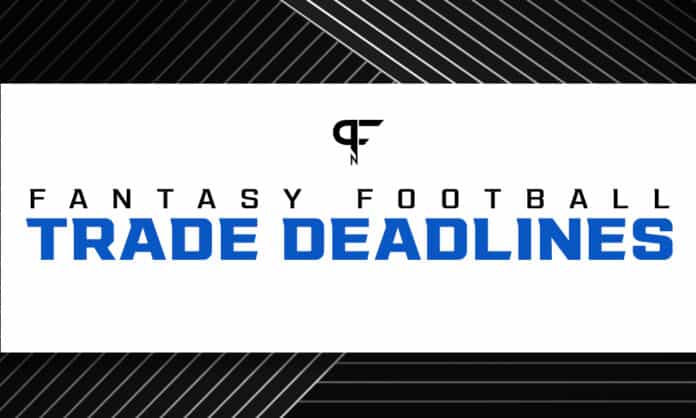One of the burning questions that often arises in the realm of fantasy football is, “Is there a trade deadline in fantasy football?” Understanding the rules and strategies surrounding trade deadlines can significantly impact the dynamics of your fantasy league. In fantasy football, trade deadlines are crucial as they determine when managers can exchange players with other teams. These deadlines can vary across different platforms and leagues, influencing how fantasy managers navigate through the season. By exploring the nuances of trade deadlines, we can uncover the advantages, challenges, and pivotal moments that arise as the deadline approaches. Let’s delve into the world of fantasy football trade deadlines and unlock the strategies that can elevate your team to victory.
Understanding Fantasy Football Trade Deadlines
In fantasy football leagues, **trade deadlines** determine the last day when team owners can make player trades. Most leagues have a trade deadline set sometime around **Week 10** or **Week 12** of the NFL season to prevent collusion or unfair advantages. Understanding these deadlines is crucial for **strategizing** your team for the playoffs.
Key Points about Trade Deadlines
Trade deadlines are usually **set by the league commissioner** and apply to all team owners.
For Inactive managers, **auto-trades or manual approvals** may be allowed by the league settings.
Implications of Missing the Deadline
**Missing the trade deadline** can limit your ability to strengthen your team for a playoff push.
- Plan Ahead: Make crucial trades before the deadline to avoid last-minute rush.
- Roster Evaluation: Assess your team’s strengths and weaknesses to determine if any trades are necessary.

Importance of Trade Deadlines in Fantasy Football
Trade deadlines in fantasy football play a crucial role in shaping the dynamics of the game. These deadlines impose restrictions on when team managers can trade players with each other, adding a layer of strategy and anticipation to the competition.
Strategic Planning
With the impending trade deadline, fantasy football managers need to carefully strategize their player acquisitions and team compositions. Strategic planning becomes paramount as managers aim to strengthen their rosters before the deadline.
Player Value Fluctuations
Leading up to the trade deadline, player values can fluctuate drastically based on real-world injuries, performance trends, and potential trades in the NFL. This period presents opportunities for astute managers to capitalize on undervalued players.
- Track player news and updates to make informed decisions
- Consider player schedules and matchups
- Assess the overall depth of your roster before making moves
Rules and Regulations Regarding Trade Deadlines
In fantasy football, understanding the rules and regulations regarding trade deadlines is crucial for managing your team effectively. Typically, there is a trade deadline in fantasy football leagues, which is usually around Week 10 or 11 of the NFL season.
Trade Deadline Timing and Implications
As the trade deadline approaches, fantasy team owners need to strategize their trades carefully to optimize their roster for the playoff push. Missing the deadline can restrict your ability to make changes to your team moving forward.
Impact on Playoff Run
Teams that make strategic moves before the trade deadline can gain a competitive edge over their opponents during the crucial playoff weeks. It’s important to analyze player matchups and plan your trades accordingly.
- Check your league’s specific trade deadline date.
- Assess your team’s strengths and weaknesses.
- Consider trading for players with favorable upcoming schedules.

Effect of Trade Deadlines on Fantasy Team Strategies
In fantasy football, understanding the impact of trade deadlines on team strategies is crucial for success. As the trade deadline approaches, fantasy team managers should assess their roster’s strengths and weaknesses to make informed decisions.
Strategic Planning Before the Deadline
Prior to the trade deadline, fantasy team managers should evaluate their team’s performance, identify areas that need improvement, and research potential trade options to strengthen their roster.
Maximizing Value through Trades
During the trade deadline period, it’s essential for fantasy managers to capitalize on favorable trade opportunities that help enhance their team’s depth and competitiveness.
- Assess the needs of other teams
- Explore trade offers strategically
- Consider leveraging the trade deadline pressure for advantageous deals
Tips for Managing Trades Close to the Deadline
As the trade deadline approaches in fantasy football, managing your trades effectively becomes crucial. Here are some tips to help you navigate the deadline period smoothly:
Plan Ahead
Research potential trade targets early in the season to have a list of players you might target as the deadline nears.
Communicate Clearly
When initiating trade talks close to the deadline, clearly express your needs and listen to what the other managers are looking for.
- Be open to negotiation and try to find a win-win situation.

Dealing with Injuries and Bye Weeks during Trade Deadlines
When managing your fantasy football team around trade deadlines, it’s essential to consider the impact of injuries and bye weeks. Injuries can significantly affect a player’s performance and availability, making it crucial to stay updated on the latest injury reports. Additionally, bye weeks can leave gaps in your lineup, requiring strategic planning to ensure you have suitable replacements.
Strategies for Dealing with Injuries
One effective strategy is to monitor injury reports regularly and have backup options ready in case a key player is ruled out. Flexibility is key when adapting to unexpected injuries, as it may be necessary to make last-minute lineup changes.
Managing Bye Weeks
During bye weeks, prioritize players from different positions to ensure a balanced lineup. Creating a bye week strategy can help you navigate through weeks with multiple key players on bye, minimizing the impact on your team’s performance.
- Consider early-season bye weeks when drafting players to avoid clustering byes in later weeks.
- Utilize the waiver wire to pick up players on bye weeks strategically.
- Plan ahead and anticipate bye week challenges to maintain a competitive roster throughout the season.
Frequently Asked Questions
-
- What is a trade deadline in fantasy football?
- A trade deadline in fantasy football is the date by which teams are no longer allowed to make trades with other teams in the league. This deadline is typically set by the league commissioner and can vary depending on the league rules.
-
- Is there a trade deadline in fantasy football?
- Yes, most fantasy football leagues have a trade deadline in place to ensure fairness and prevent collusion among teams. The trade deadline is usually around mid-season but can differ from league to league.
-
- What are some strategies related to the trade deadline in fantasy football?
- Teams in fantasy football often strategize around the trade deadline by making deals to strengthen their roster before the deadline hits. Some may target players with favorable schedules for the playoffs, while others may look to offload injured or underperforming players.
-
- Can trades be made after the trade deadline in fantasy football?
- In most leagues, trades are not allowed after the trade deadline has passed. This rule is put in place to maintain the integrity of the competition and prevent any unfair advantages for teams late in the season.
-
- How does the trade deadline impact player value in fantasy football?
- The trade deadline can significantly impact player value in fantasy football. Teams may be more willing to trade away star players for future prospects or draft picks if they are out of playoff contention, while playoff-bound teams may look to acquire key players for their championship push.
In Summary: Understanding the Trade Deadline in Fantasy Football
In conclusion, the presence of a trade deadline in fantasy football can significantly impact a team’s strategy and performance. While some leagues may enforce a deadline to maintain fairness and prevent collusion, others operate without such restrictions, allowing continuous trading throughout the season. Knowing the trade deadline rules in your league is crucial for making informed decisions and maximizing your team’s potential. Whether you are a seasoned manager or a beginner, understanding when you can make trades can make or break your fantasy season. Stay informed, adapt your strategies accordingly, and always aim to improve your team until the very end.





